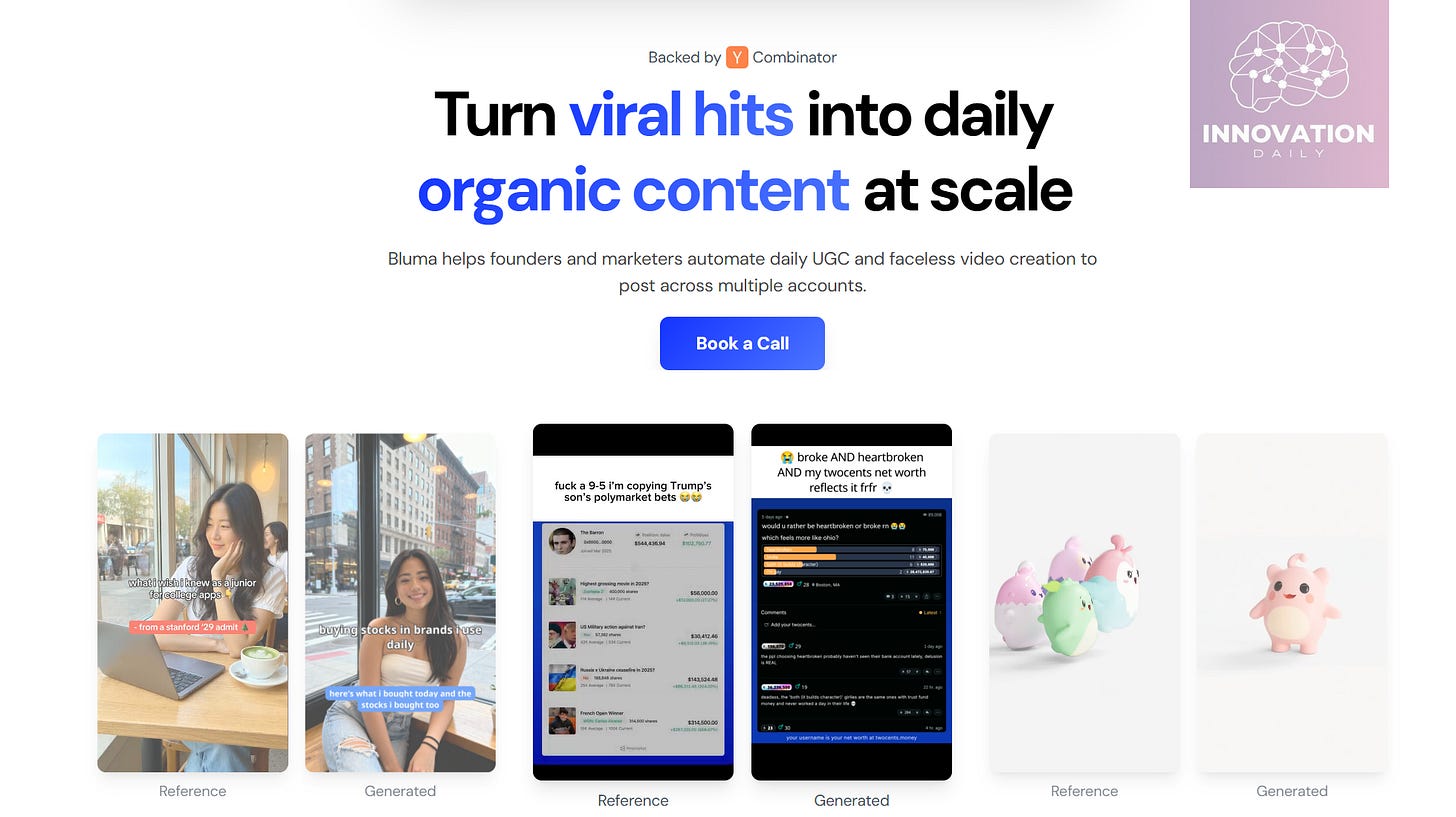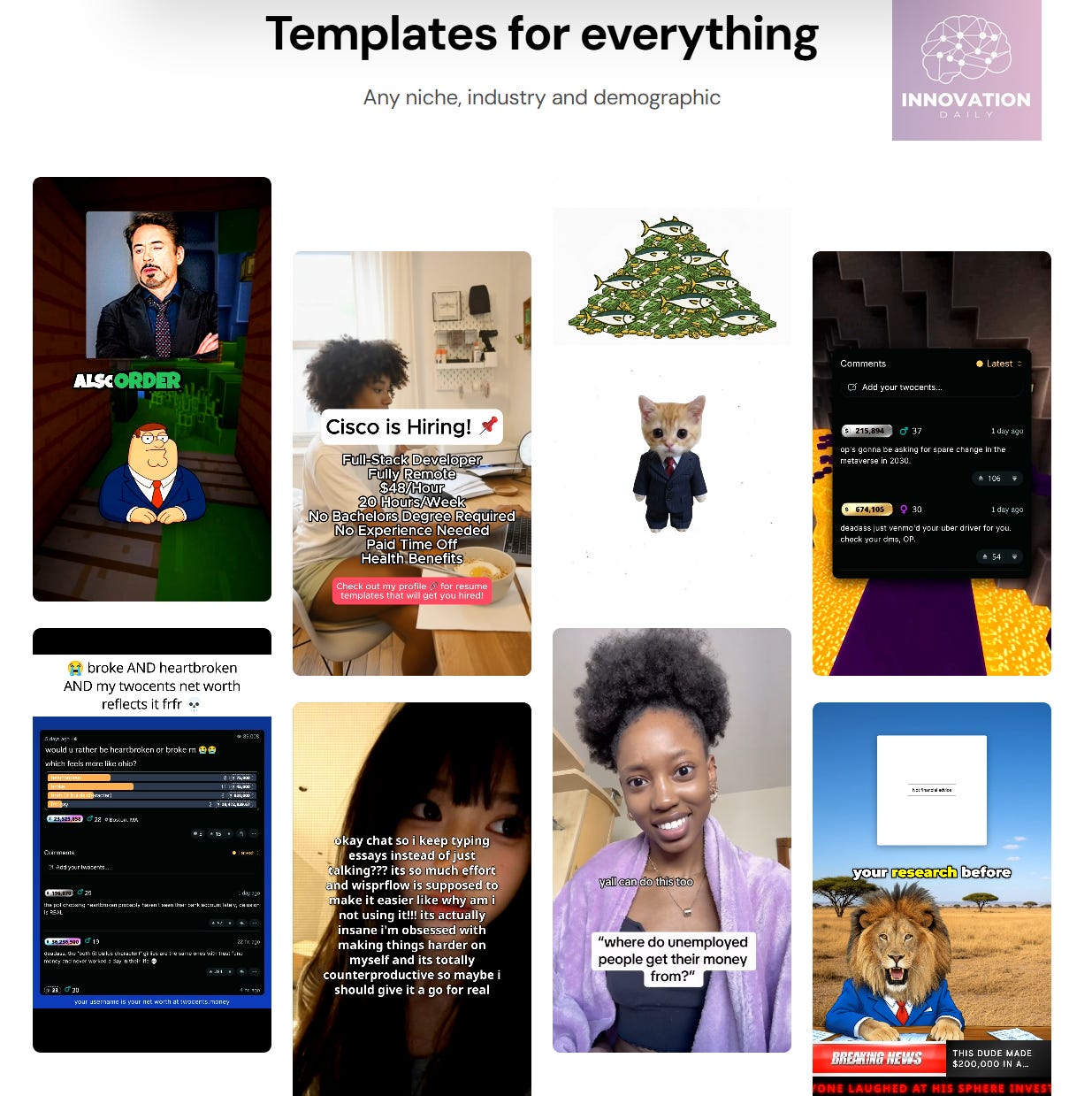Stop Guessing. Start Producing.
Today's featured startup is decoding viral clips and transforming them into a repeatable system for growth
Project Overview
Bluma has built a platform that helps brands turn viral videos into a steady stream of fresh, daily content — and do it at scale.
Companies use Bluma in two main ways:
• to publish “organic-looking” user-generated videos on their TikTok and Instagram accounts
• to generate performance-ready creatives for TikTok, Facebook, and Instagram ads
Traditionally, teams brainstorm an idea, produce scenes across different AI video tools, and then stitch everything together in CapCut or similar editors. Bluma collapses this entire workflow into a single step.
You give the platform a viral video you want to emulate. Bluma’s AI analyzes it, writes a similar storyline tailored to your product, generates matching visuals, edits the footage, and delivers a complete, ready-to-publish clip.
At the same time, the end result isn’t a clone. Bluma keeps the essence of the source video — its creative composition, the roles of the characters, and the overall mechanic of “what happens and how” — without crossing into imitation. The output looks fresh, not copy-pasted, which is exactly what most brands struggle to achieve.
The key innovation: Bluma extracts the “signature pattern” of a viral video and turns it into an internal template the system can reuse. The platform already ships with a catalog of these templates — all derived from high-performing viral videos — but clients can upload their own source clips to generate new templates and expand the library.
Bluma launched only recently, yet revenues are growing 100% week over week, reaching a projected $28,000 in monthly recurring revenue after just four weeks. One of its largest clients uses only eight templates — yet publishes twice a day on 16 accounts, already demonstrating meaningful scale.
The startup is currently part of Y Combinator, and its official launch appeared on YC’s website just yesterday.
What’s the Gist?
Two forces define today’s online promotion landscape:
Short-form video has become the dominant medium — audiences prefer it over every other format.
Volume is now the single biggest driver of results — brands need a high posting frequency to stay visible in an ocean of content.
And yet, video production is still painfully slow. Coming up with a concept, writing a script, creating or sourcing footage, editing, testing, and coordinating distribution takes time, budget, and team capacity.
This process touches several giant markets at once:
• $200B influencer and user-generated content economy
• $32B video creation and editing software market
• $180B digital advertising market
In other words, video means money — and headaches.
Some companies have started building “content factories” to publish 10–15K videos per month, often repurposing near-identical clips across dozens of accounts and platforms. But running such operations is expensive, complex, and dependent on large teams. Most brands simply can’t pull it off.
This has opened the door for “AI content factories” — platforms that offer similar output volumes with far fewer resources and far lower expertise.
Y Combinator alumni GetCrux built one such platform: an “AI ad strategist” that discovers high-performing competitor ads, analyzes why they work, and generates new versions tailored to a store’s products. It mirrors the exact logic used by human-run content factories: track viral videos, extract the secret sauce, and make similar ones at scale.
Another example is Extuitive, which raised $20M in its first round. For Shopify stores, its AI suggests which products to promote and generates the corresponding images or videos. It even tests creatives on simulated audience personas before publishing.
The entire market is shifting in the same direction — from “create videos manually” to “automate and scale video production intelligently.”
Key Takeaways
The direction is clear: companies will increasingly rely on AI-powered content factories. Manual content factories are expensive, slow, and operationally messy; pure AI platforms, on the other hand, often fail to deliver consistent, high-quality results on their own.
Why? Because even the best AI platform still needs humans — people who curate ideas, select samples, review outputs, improve scripts, and monitor performance. Reduce the human input to zero, and the output becomes mediocre. Increase it too much, and the process becomes costly again.
This mirrors the story of GrowthX. After scaling organic traffic from 1,000 to 30,000 visitors per day using a highly repeatable content process, the founder tried teaching other companies to replicate the system. Everyone loved the idea — but nobody had the time or capacity to implement it.
So he built GrowthX not as a platform, but as an AI-powered service that does everything for the client. The result: from $0 in July 2024 to $700K in revenue by April 2025.
Video production is heading in the same direction.
The winning model likely isn’t just an AI tool — it’s an AI agency:
a service that combines platform automation with curated human oversight, delivering high-volume, high-quality creatives without requiring clients to build internal teams.
Bluma is part of this shift — and signals where the industry is moving next.
Company Info
Bluma
Website: getbluma.com
Latest Round: $500K 01.10.2025
Total Funding: $500K across 1 round









